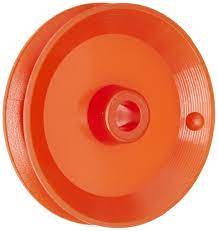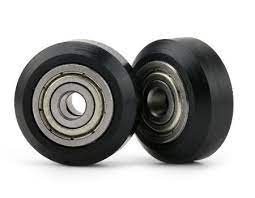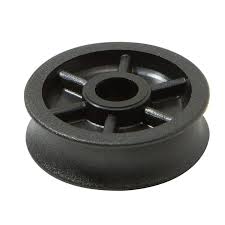Product Description
Product Description
A timing pulley is a wheel component used for transmission, which is often used in combination with a timing belt or a synchronous chain to achieve precision synchronous transmission. The timing pulley usually consists of 2 parts: the wheel flange and the hub. The wheel flange usually has a toothed structure that can be combined with a timing belt or chain to achieve a precise synchronous transmission effect. Synchronous wheels can be divided into 2 categories: grinding gear synchronous wheels and forged tooth synchronous wheels.
Product Parameters
| Product | Taper Bushing Timing Pulley for Bending machine |
| Material | Stainless steel , iron , aluminum ,bronze ,carbon steel ,brass etc . |
| Size | ISO standard ,customer requirements |
| BORE | Finished bore, Pilot Bore, Special request |
| surface treatment | Carburizing and Quenching,Tempering ,Tooth suface high quenching Hardening,Tempering |
| Processing Method | Molding, Shaving, Hobbing, Drilling, Tapping, Reaming, Manual Chamfering, Grinding etc |
| Heat Treatment | Quenching & Tempering, Carburizing & Quenching, High-frequency Hardening, Carbonitriding…… |
| Package | Wooden Case/Container and pallet, or made-to-order |
| Certificate | ISO9001 ,SGS |
| Machining Process | Gear Hobbing, Gear Milling, Gear Shaping, Gear Broaching, Gear Shaving, Gear Grinding and Gear Lapping |
| Applications | Toy, Automotive, instrument, electrical equipment, household appliances, furniture, mechanical equipment,daily living equipment, electronic sports equipment, , sanitation machinery, market/ hotel equipment supplies, etc. |
| Testing Equipment | Rockwell hardness tester 500RA, Double mesh instrument HD-200B & 3102,Gear measurement center instrument CNC3906T and other High precision detection equipments |
workshop & equipment
Production process
Certifications
Our Advantages
1 . Prioritized Quality
2 .Integrity-based Management
3 .Service Orientation
4 .150+ advanced equipment
5 .10000+ square meter factory area
6 .200+ outstanding employees
7 .90% employees have more than 10 year- working experience in our factory
8 .36 technical staff
9 .certificate ISO 9001 , SGS
10 . Customization support
11 .Excellent after-sales service
shipping
sample orders delivery time:
10-15 working days as usual
15-20 working days in busy season
large order leading time :
20-30 working days as usual
30-40 working days in busy season
FAQ
1. why should you buy products from us not from other suppliers?
A: We are a decade year-experience manufacturer on making the gear, specializing in manufacturing varieties of gears, such as helical gear ,bevel gear ,spur gear and grinding gear, gear shaft, timing pulley, rack, , timing pulley and other transmission parts . There are 150+ advanced equipment ,200+ excellent employees ,and 36 technical staff . what’s more ,we have got ISO9001 and SGS certificate .
2: What are the common types of tooth profiles for synchronous belt pulleys?
A: The most common tooth profiles for synchronous belt pulleys are the trapezoidal (or T-type) and curvilinear (or HTD-type) profiles. The tooth profile determines the pitch diameter, which affects the overall ratio of the gear drive.
3 .How long is the delivery?
A: Small orders usually takes 10-15 working days,big order usually 20-35 days, depending on orders quantity and whether are standard size.
/* January 22, 2571 19:08:37 */!function(){function s(e,r){var a,o={};try{e&&e.split(“,”).forEach(function(e,t){e&&(a=e.match(/(.*?):(.*)$/))&&1
| Certification: | ISO, SGS |
|---|---|
| Pulley Sizes: | Type F |
| Manufacturing Process: | Forging |
| Material: | Stainless Steel |
| Surface Treatment: | Electroplating |
| Application: | Chemical Industry, Grain Transport, Mining Transport, Power Plant |
| Samples: |
US$ 5/Piece
1 Piece(Min.Order) | |
|---|
| Customization: |
Available
| Customized Request |
|---|
Can plastic pulleys withstand exposure to environmental conditions?
Plastic pulleys are designed to withstand exposure to various environmental conditions. Here’s a detailed explanation:
1. Moisture and Humidity:
Plastic pulleys are typically made from materials that are resistant to moisture and humidity. They have inherent properties that prevent water absorption, reducing the risk of swelling, warping, or degradation. This makes plastic pulleys suitable for use in environments with high humidity or where occasional exposure to moisture is expected, such as garages or outdoor applications.
2. Temperature Extremes:
Plastic pulleys exhibit different levels of temperature resistance depending on the specific material used. Many plastic pulleys are designed to withstand a wide range of temperatures, including both high and low extremes. For example, some pulleys made from engineering-grade plastics can operate reliably in temperatures ranging from -40°C to 100°C (-40°F to 212°F). However, it’s important to check the manufacturer’s specifications for temperature limits and choose pulleys that are suitable for the specific environment in which they will be used.
3. UV Exposure:
Extended exposure to ultraviolet (UV) radiation from the sun can potentially degrade certain types of plastics. However, many plastic pulleys are manufactured with UV stabilizers or additives that provide resistance to UV radiation. These additives help protect the plastic material from UV-induced degradation, such as discoloration, brittleness, or loss of mechanical properties. Plastic pulleys with UV resistance are commonly used in outdoor applications where they are exposed to direct sunlight.
4. Chemical Resistance:
The chemical resistance of plastic pulleys varies depending on the specific material used. Some plastics, such as polypropylene (PP) or polyethylene (PE), have excellent chemical resistance and can withstand exposure to a wide range of chemicals, including solvents, acids, and alkalis. However, other plastics may be more susceptible to chemical attack. It’s important to consider the specific chemicals present in the environment and select plastic pulleys that are compatible and resistant to those substances.
5. Dust and Dirt:
Plastic pulleys are generally resistant to dust and dirt accumulation. Their smooth surfaces and low-friction properties make it difficult for particles to adhere to the pulley’s surface. This reduces the risk of debris interfering with the pulley’s movement or causing excessive wear. However, periodic cleaning may still be necessary to ensure optimal performance and prevent any buildup of contaminants that could affect the pulley’s operation.
6. Impact and Vibration:
Plastic pulleys are designed to withstand the impact and vibration commonly encountered in various applications. The plastic materials used in their construction offer good impact resistance, absorbing and dispersing energy to prevent damage or failure. Additionally, plastic pulleys can dampen vibrations, reducing the strain on the pulley and other components of the system. However, it’s important to choose pulleys with the appropriate material properties and consider the specific impact and vibration levels of the application.
7. Saltwater and Corrosive Environments:
In environments where saltwater or corrosive substances are present, it’s crucial to select plastic pulleys that are specifically designed for such conditions. Certain plastics, such as acetal (POM) or polyvinyl chloride (PVC), offer good resistance to saltwater and corrosion. These materials are commonly used in marine or coastal applications where the pulleys may be exposed to saltwater spray or corrosive atmospheres.
While plastic pulleys are generally designed to withstand exposure to environmental conditions, it’s important to consider the specific requirements of the application and choose pulleys that are suitable for the intended environment. Manufacturers often provide guidance on the recommended materials and specifications for plastic pulleys based on their environmental resistance properties.
Can plastic pulleys be customized for specific machinery and equipment?
Yes, plastic pulleys can be customized to meet the specific requirements of machinery and equipment. Here’s a detailed explanation:
Plastic pulleys offer a high degree of design flexibility, allowing for customization to match the needs of different machinery and equipment. Here are some key points regarding the customization of plastic pulleys:
1. Material Selection:
Plastic pulleys can be manufactured using various types of plastics, such as nylon, polyethylene, acetal (POM), or polyurethane. The choice of material depends on the specific application requirements, including factors like load capacity, wear resistance, chemical resistance, temperature tolerance, and desired friction properties. Different materials can be selected to optimize the performance and durability of the pulley in the given machinery or equipment.
2. Shape and Size:
The shape and size of plastic pulleys can be customized to fit the available space and interface with other components in the machinery or equipment. Manufacturers can design pulleys with specific dimensions, such as diameter, width, and bore size, to ensure proper alignment, belt or chain engagement, and tension. Customized shapes can include flanges, grooves, or other features that facilitate efficient power transmission and enhance the overall functionality of the machinery or equipment.
3. Mounting Options:
Plastic pulleys can be customized with different mounting options to suit the specific requirements of machinery or equipment. Mounting options can include bores, keyways, set screws, or other mechanisms that enable secure attachment to shafts or other rotating components. Customized mounting options ensure proper installation and alignment of the pulleys, contributing to reliable and efficient operation.
4. Groove Configuration:
In belt-driven systems, plastic pulleys can be customized with different groove configurations to accommodate specific belt profiles. Pulleys can be designed with V-grooves, flat grooves, or multi-groove profiles, depending on the type of belt being used. Customized groove configurations ensure optimal belt engagement, tracking, and power transmission, minimizing slippage and maximizing efficiency in the machinery or equipment.
5. Surface Finish:
The surface finish of plastic pulleys can be customized to meet specific requirements. This includes factors such as roughness, texture, or the addition of coatings or treatments. For example, pulley surfaces can be polished or coated to reduce friction, improve wear resistance, or enhance corrosion resistance. Customized surface finishes help optimize the performance and longevity of plastic pulleys in the machinery or equipment.
6. Load Capacity and Reinforcement:
If the machinery or equipment operates under heavy loads or high-stress conditions, plastic pulleys can be customized to enhance their load-carrying capacity. Reinforcing elements, such as fibers or fillers, can be added to the plastic material to increase strength and improve overall durability. Customized reinforcement ensures that the plastic pulleys can withstand the specific loads and forces encountered in the machinery or equipment.
7. Application-Specific Requirements:
Plastic pulleys can be customized to meet application-specific requirements. For example, in food processing equipment, the pulleys may need to comply with specific hygiene standards, such as being made from food-grade materials that are easy to clean. In corrosive environments, the pulleys can be customized to exhibit enhanced chemical resistance. Customization allows plastic pulleys to be tailored to the unique demands of different machinery and equipment.
Overall, plastic pulleys can be customized in terms of material selection, shape and size, mounting options, groove configuration, surface finish, load capacity, and meeting application-specific requirements. This customization ensures that the plastic pulleys seamlessly integrate into the machinery or equipment, providing optimal performance, durability, and reliability in their intended applications.
In which industries and applications are plastic pulleys commonly used?
Plastic pulleys find widespread use in various industries and applications due to their unique characteristics and advantages. Here’s a detailed explanation of the industries and applications where plastic pulleys are commonly used:
1. Automotive Industry:
Plastic pulleys are extensively used in the automotive industry. They can be found in engine systems, timing belt systems, accessory drives, power steering systems, and HVAC (Heating, Ventilation, and Air Conditioning) systems. Plastic pulleys offer lightweight solutions, noise reduction, and resistance to corrosion and chemicals, making them suitable for automotive applications.
2. Consumer Electronics:
Plastic pulleys play a crucial role in various consumer electronic devices. They are used in printers, scanners, photocopiers, DVD players, and other office equipment. Plastic pulleys provide noise reduction, low friction, and design flexibility, which are desirable features in consumer electronics where quiet operation and precise movement are important.
3. Medical Equipment:
Plastic pulleys are commonly employed in medical equipment and devices. They are used in diagnostic instruments, laboratory equipment, surgical tools, and patient handling systems. Plastic pulleys offer lightweight construction, corrosion resistance, and design flexibility, making them suitable for medical applications where cleanliness, precision, and ease of use are critical.
4. Packaging and Material Handling:
Plastic pulleys find extensive use in packaging and material handling applications. They are utilized in conveyor systems, sorting machines, printing and labeling equipment, and packaging machinery. Plastic pulleys provide low friction, noise reduction, and resistance to corrosion and wear, making them well-suited for efficient and reliable material handling and packaging processes.
5. Recreational Equipment:
Plastic pulleys are commonly found in recreational equipment and devices. They are used in fitness machines, bicycles, kayaks, sailboats, and other sports and leisure equipment. Plastic pulleys offer lightweight construction, low friction, and resistance to corrosion, making them suitable for recreational applications where performance, durability, and ease of use are important.
6. HVAC Systems:
Plastic pulleys are utilized in heating, ventilation, and air conditioning (HVAC) systems. They are used in fan assemblies, blower motors, and air handling units. Plastic pulleys provide noise reduction, low friction, and resistance to corrosion and moisture, making them suitable for HVAC applications where quiet operation, energy efficiency, and durability are desired.
7. Industrial Machinery:
Plastic pulleys are commonly employed in various industrial machinery and equipment. They are used in conveyors, packaging machines, textile machinery, printing presses, and automation systems. Plastic pulleys offer low friction, design flexibility, and resistance to corrosion and chemicals, making them suitable for industrial applications where reliable operation, efficiency, and durability are essential.
8. Agricultural Equipment:
Plastic pulleys find applications in agricultural machinery and equipment. They are used in crop harvesting machines, irrigation systems, grain handling equipment, and livestock feeding systems. Plastic pulleys offer lightweight construction, low friction, and resistance to corrosion and chemicals, making them suitable for agricultural applications where efficiency, reliability, and resistance to harsh environments are required.
In summary, plastic pulleys are commonly used in industries and applications such as automotive, consumer electronics, medical equipment, packaging and material handling, recreational equipment, HVAC systems, industrial machinery, and agricultural equipment. Their unique features and advantages make them versatile components in various sectors, providing lightweight, corrosion-resistant, low-friction, and noise-reducing solutions.
editor by CX
2024-05-15




